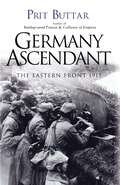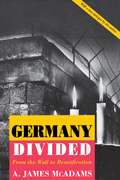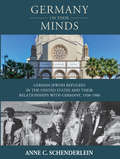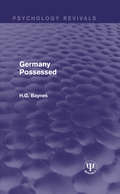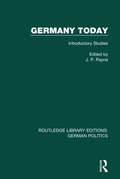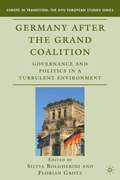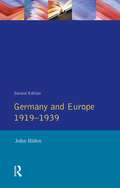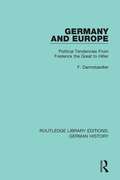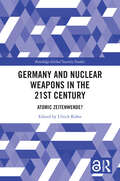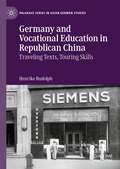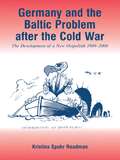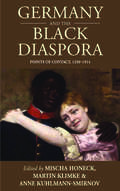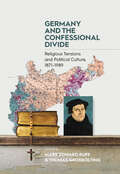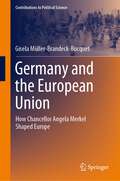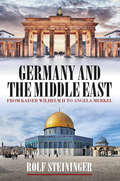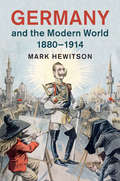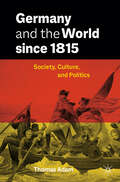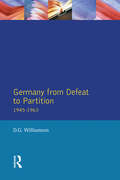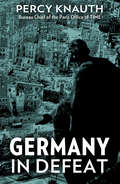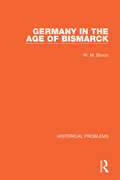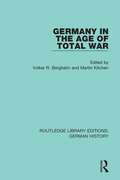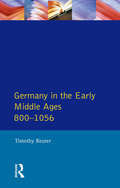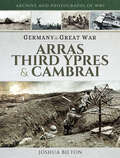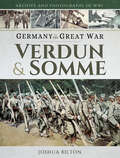- Table View
- List View
Germany Ascendant
by Prit ButtarWhile millions of men died in France and Belgium in 1915, battles equally as large and bloody were being fought on the Eastern Front, as Imperial Germany, Hapsburg Austria-Hungary, and Tsarist Russia clashed on a scale greater than anything seen on the Western Front. These massive offensives were shocking in their scale and intensity, and hugely important. Yet they are largely ignored in the West. Now, with the work of internationally renowned Eastern Front expert Prit Buttar, this story of the unknown side of World War I is finally being told.In Germany Ascendant, Buttar examines the critical year of 1915, when Germany launched the great Gorlice-Tarnow Offensive, lead by Field Marshal Mackensen. The move, which started as a minor German operation to relieve their Austro-Hungarian allies, ultimately resulted in the utter collapse of Russian forces from all of Poland and Gallacia, and came tantalizingly close to knocking Russia out of the war altogether. Next the Germans led the invasion of Serbia, leading Britain and France to intervene with ground troops, an operation that ultimately failed. Yet despite this unbroken string of successes, Germany was still hamstrung by a two-front war. Her every attempt to knock Russia out of the war--military and diplomatic--has failed. The stage was then set for the next phase of the war when Russia launched its own counter-offensive that nearly brought the Central Powers to their knees.
Germany Divided: From the Wall to Reunification (Princeton Studies in International History and Politics #182)
by A. James McAdamsGermany Divided remains one of the most thought-provoking and comprehensive interpretations of the forty-year relationship between East and West Germany and of the problems of contemporary German unity. In this politically controversial and analytically sophisticated account, A. James McAdams dissects the complex process by which East and West German leaders moved over the years from first pursuing the ideal of German unity, to accepting what they believed to be the inescapable reality of division, and then, finally, to meeting the challenges of an unanticipated reunification. This new edition contains an epilogue in which McAdams considers some of the political and economic problems faced by eastern and western Germans as they entered their fourth year of living together.
Germany On Their Minds: German Jewish Refugees in the United States and Relationships with Germany, 1938–1988 (Studies in German History #25)
by Anne C. SchenderleinThroughout the 1930s and early 1940s, approximately ninety thousand German Jews fled their homeland and settled in the United States, prior to that nation closing its borders to Jewish refugees. And even though many of them wanted little to do with Germany, the circumstances of the Second World War and the postwar era meant that engagement of some kind was unavoidable—whether direct or indirect, initiated within the community itself or by political actors and the broader German public. This book carefully traces these entangled histories on both sides of the Atlantic, demonstrating the remarkable extent to which German Jews and their former fellow citizens helped to shape developments from the Allied war effort to the course of West German democratization.
Germany Possessed (Psychology Revivals)
by H.G. BaynesOriginally published in 1941, the blurb read: "The aim of this work is to state and understand the psychological dynamics of the present conflict. The author is a medical psychologist who has had unusual opportunities for studying German mentality. He characterizes the condition of Germany as one of dæmonic possession and Hitler as the primitive medicine-man who gained a magical ascendency by playing the role of medium to the German unconscious. He analyses the fundamental instability of the collective German psychology and relates this to the dæmonic outbreak. The ambiguous personality of the Führer is seen as the indispensable symbol of a deeply divided nation striving for unity. Whereas the pagan-Christian conflict in the soul of Christendom is urging individual consciousness to a new statement of human values, it has produced in the soul of Germany a state of collective intoxication which is the negation of individuality. This book is the first serious attempt to depict the invisible underground causes of the European catastrophe and to state the issue in terms of epochal transition. It was German violence which started the conflagration, but the fires of anti-Christian revolt have long been smouldering in the general unconscious. Material of a varied kind, gathered from German myth and legend and from a number of contemporary witnesses has been pieced together into a comprehensive psychological survey, embracing both the personal and the impersonal aspects of the German scene. Hitler is discussed as personality, as symbol, and as a disease. The influence of the Wagnerian German myth upon Hitler’s inflammable imagination is discussed and the basic ideas of Hitlerism are traced to their source. This is the attempt of psychology to elucidate the irrational and unintelligible elements in the present chaos."
Germany Today: Introductory Studies (Routledge Library Editions: German Politics)
by John P. PayneThis book, originally published in 1971, provides clear analysis of German affairs at the end of the 1960s. Without neglecting the historical dimension of recent developments, it examines some of the problems the German people faced in the post-war years. Written by experts, but nonethless in an accessible style the essays in this book give an insight into the methods of particular disciplines such as history, economics, politics or sociology whilst offering an introduction to many aspects of German life.
Germany after the Grand Coalition
by Silvia Bolgherini Florian GrotzIn Germany, Grand Coalitions of the two major parties - the Christian Democrats (CDU/CSU) and the Social Democrats (SPD) - generally have a bad reputation. Hence, the CDU/CSU-SPD government under Angela Merkel (2005-2009) was neither the parties' nor the citizens' preferred choice, its performance was seen quite critical from the outset, and it was finished without further ado after the 2009 federal election. Has the Grand Coalition 2005-2009 been a single episode or rather a turning point for German politics? This book provides a retrospective of the first Merkel government, an analysis of the 2009 election and an account of its prospective consequences.
Germany and England: Background of Conflict 1848-1894
by Raymond James SontagWritten just before the onset of the Second World War, this work provides a detailed view of the development of these two countries and their slide to rivalry and war. Its pre 1939 date allows a perspective unsullied by WWII and the Nazis, making a honest attempt at objectivity.
Germany and Europe 1919-1939
by John HidenThis is the only short study in English to survey Germany's foreign policy from a German viewpoint across the entire inter-war period. The approach, which sets Germany in her full European context, is not narrowly diplomatic; and it gives as much attention to the Weimar years of the 1920s as it gives to the more familiar story of Germany's international relations under the Third Reich. John Hiden has now thoroughly revised his text to take account of new scholarship since the book first appeared in 1977.
Germany and Europe: Political Tendencies From Frederick the Great to Hitler (Routledge Library Editions: German History #7)
by F. DarmstaedterOriginally published in 1945, at a time when feelings against the German people were running high, this book is as much a revealing insight into the psyche of the Germans as it is a history of Germany from the late 18th century to the end of WWII. The author firmly believed that a path of reconciliation and a peaceful future for relations with Germany could only be achieved by understanding key episodes from the country’s past.
Germany and Nuclear Weapons in the 21st Century: Atomic Zeitenwende? (Routledge Global Security Studies)
by Ulrich KühnThis book is the first scholarly book to take a comprehensive look at Germany’s nuclear weapons policies in the 21st century.German foreign and security policy is facing a profound reorientation. Great power competition between the United States and both a revanchist Russia and a rising China, the return of war and nuclear threats to Europe, and the emergence of new technologies all force Germany to adapt. German policymakers and scholars increasingly speak of a pivotal Zeitenwende, an epochal turning point in history. How does Germany adapt its nuclear policies to these changing conditions?The volume brings together internationally renowned nuclear scholars and policy analysts from Germany and abroad. Focussing on German nuclear deterrence, arms control and disarmament as well as nonproliferation policies, the contributors assess how German leaders have navigated continuity and change, domestically and abroad. The volume concludes that Germany remains bound by dependence on the United States and its own conservatism. Within these parameters, German leaders have adapted slowly to change and continue to balance seemingly contradictory deterrence and disarmament goals.This book will be of much interest to students of nuclear proliferation, security studies, German politics and International Relations, as well as policymakers.
Germany and Vocational Education in Republican China: Traveling Texts, Touring Skills (Palgrave Series in Asian German Studies)
by Henrike RudolphThis book offers a new perspective on the transnational dimensions of China’s educational and economic history by focusing on Sino-German interactions in the field of vocational education. It explores how Chinese perceptions of manual work, vocational skills, and educational practices changed dramatically throughout the first half of the twentieth century as Chinese educators increased their efforts to study and translate German pedagogical writings. Case studies researched in this book illustrate how a Chinese appreciation for German technological and scientific advances and German interests in profiting from a growing Chinese economy are not just recent phenomena but have their roots in the early twentieth century.
Germany and the Baltic Problem After the Cold War: The Development of a New Ostpolitik, 1989-2000
by Kristina Spohr ReadmanThe root question this book addresses is how the new Germany will use its re-found status as a great power. Does Germany - as in the past - aim to dominate Europe? Or has it renounced its imperial ambitions following the trauma of division during the Cold War?In seeking answers to these questions, Kristina Spohr Readman scrutinises the development of Germany's new Ostpolitik (eastern policy) in the period 1989-2000. Against the background of recent European history, she analyses the re-establishment of a special relationship between Bonn/Berlin and Moscow. In particular, she assesses the peculiar geopolitical situation of the Baltic states: caught between a turbulent Russia in the east and a unified Germany in the west. The Baltic case reveals the complexities of a post-Cold War European security architecture in the making.
Germany and the Black Diaspora: Points of Contact, 1250-1914
by Martin Klimke Anne Kuhlmann Mischa HoneckThe rich history of encounters prior to World War I between people from German-speaking parts of Europe and people of African descent has gone largely unnoticed in the historical literature-not least because Germany became a nation and engaged in colonization much later than other European nations. This volume presents intersections of Black and German history over eight centuries while mapping continuities and ruptures in Germans' perceptions of Blacks. Juxtaposing these intersections demonstrates that negative German perceptions of Blackness proceeded from nineteenth-century racial theories, and that earlier constructions of "race" were far more differentiated. The contributors present a wide range of Black-German encounters, from representations of Black saints in religious medieval art to Black Hessians fighting in the American Revolutionary War, from Cameroonian children being educated in Germany to African American agriculturalists in Germany's protectorate, Togoland. Each chapter probes individual and collective responses to these intercultural points of contact.
Germany and the Confessional Divide: Religious Tensions and Political Culture, 1871-1989
by Mark Edward Ruff and Thomas GroßböltingFrom German unification in 1871 through the early 1960s, confessional tensions between Catholics and Protestants were a source of deep division in German society. Engaging this period of historic strife, Germany and the Confessional Divide focuses on three traumatic episodes: the Kulturkampf waged against the Catholic Church in the 1870s, the collapse of the Hohenzollern monarchy and state-supported Protestantism after World War I, and the Nazi persecution of the churches. It argues that memories of these traumatic experiences regularly reignited confessional tensions. Only as German society became increasingly secular did these memories fade and tensions ease.
Germany and the European Union: How Chancellor Angela Merkel Shaped Europe (Contributions to Political Science)
by Gisela Müller-Brandeck-BocquetThis book aims to present a coherent picture of Germany’s European policy during Merkel’s chancellorship. At the same time, it traces the development of the EU in the period 2005–2021. Accordingly, the European crises and the internal and external threats to the integration community are addressed, as well as the jointly developed solutions. Thus, on the one hand, the book shows what Germany was willing to do for Europe; on the other, it reveals how the EU was able to develop further as the most important point of reference for German politics and power.
Germany and the Middle East: From Kaiser Wilhelm II to Angela Merkel
by Rolf SteiningerFor over a century, the Middle East has weathered seemingly endless conflicts, ensnaring political players from around the world. And perhaps no nation has displayed a greater range of policies toward, and experiences in, the region than Germany, as this short and accessible volume demonstrates. Beginning with Kaiser Wilhelm’s intermittent support for Zionism, it follows the course of German-Mideast relations through two world wars and the rise of Adolf Hitler. As Steininger shows, the crimes of the Third Reich have inevitably shaped postwar German Mideast policy, with Germany emerging as one of Israel’s staunchest supporters while continuing to navigate the region’s complex international, religious, and energy politics.
Germany and the Modern World, 1880–1914
by Mark HewitsonThe German Empire before 1914 had the fastest growing economy in Europe and was the strongest military power in the world. Yet it appeared, from a reading of many contemporaries' accounts, to be lagging behind other nation-states and to be losing the race to divide up the rest of the globe. This book is an ambitious re-assessment of how Wilhelmine Germans conceived of themselves and the German Empire's place in the world in the lead-up to the First World War. Mark Hewitson re-examines the varying forms of national identification, allegiance and politics following the creation and consolidation of a German nation-state in light of contemporary debates about modernity, race, industrialization, colonialism and military power. Despite the new claims being made for the importance of empire to Germany's development, he reveals that the majority of transnational networks and contemporaries' interactions and horizons remained intra-European or transatlantic rather than truly global.
Germany and the World since 1815: Society, Culture, and Politics
by Thomas AdamThis textbook provides a history of modern Germany, locating the country’s social, cultural, and political developments within their proper global and transnational context. The author argues that most developments in German culture, society, and politics throughout the nineteenth and twentieth centuries were caused by wider global and transnational trends. A history of the German people rather than the German state, the book focusses on non-state and non-government actors, intercultural transfers, and applies the approach of ‘thick description’ to analysing the creation of German culture, society, and identity from the era of the Napoleonic wars right up to the present post-unification Germany. This includes an examination of German migrants’ journeys to their new homes in the Americas and, thus, the creation of a global German diaspora with cultural and social networks beyond its home country’s borders. The book further focusses on the transfers that connected German society and culture with those of other countries; for instance, chapters cover the transfer of football from England to Germany, the transfer of the Christmas holiday tradition from Germany to other countries, and the development of eugenics in Germany within its global context.
Germany from Defeat to Partition, 1945-1963 (Seminar Studies)
by D. G. WilliamsonThis book covers the years, 1945-63 which witnessed th total defeat of the Third Reich, the occupation a nd evolution of the German Federal Republic and German Democratic Republic. The impact of the occupation is analysed, as are the events leading to the division of Germany. Politics, economic history and social and cultural change in both Germanys are fully explored. Thus in the FRG the nature of Adenauer's success in creating a parliamentary democracy is analysed, as is the West German 'economic miracle'.There is also a chapter specifically on social and cultural developments i nthe FRG. The GDR is treated equally comprehensively with particular attention being paid to the Socialist Unity Party and how it was able to dominate the GDR and survive the riots of 17-18 June 1953. The events leading up to the construction of the Berlin Wall are also carefully covered. In the Conclusion a comparative summary of the two German states is made in the light of key themes.
Germany in Defeat
by Pierre Van Paassen Percy KnauthGermany in Defeat, first published in 1946, is the first hand, detailed account of Germany at the end of World War Two by Time correspondent Percy Knauth. The book details Knauth's travels across the war-ravaged country: from Berlin to concentration camps including Buchenwald and Salispilz, from Hitler's bunker to his mountain retreat (the Berghof at Berchtesgaden), and his interviews with German, American, and Russian military officials and German civilians. His visit to Hitler's underground bunker in Berlin just days after Hitler committed suicide is a fascinating story, and his description of Buchenwald provides a unique, chilling look at the conditions and workings of the Nazi death camp.Percy Knauth, an American who attended school in Germany, worked first for the Chicago Tribune in Berlin, then for the New York Times. In 1942, he was the Paris Bureau Chief for Time magazine, and spent the next 28 years working for Time-Life publications in Paris, Berlin and New York. He retired as European editor in 1970 to devote his time to writing. Knauth died in 1995 at the age of 80.
Germany in the Age of Bismarck
by W. M. SimonOriginally published in 1968, this was the first time that a comprehensive selection of documents on Germany in the Age of Bismarck had been made available to students and other readers in the English language. The documents were chosen to illuminate not only Bismarck’s own personality and policies but also the nature of the problems he faced and the reactions of his contemporaries. The substantial introduction serves as a general background and guide to the documents, which are in the form of letters, essays, polemics, speeches, and memoirs, produced in the period itself. They allow the student to obtain a genuine first-hand insight into the workings of minds and institutions in Germany during three of the most eventful decades of her history.
Germany in the Age of Total War (Routledge Library Editions: German History #2)
by Volker R. Berghahn Martin KitchenOriginally published in 1981 and now re-issued with a new Preface, this book contains contributions on key issues such as the origins of the First World War, the psychological impact of that war on the Germans, the enigmatic personality of Walter Rathenau, anti-semitism and paramilitarism, as well as German Ostpolitik during the Weimar period. The collapse of the Weimar Republic is re-examined and this is followed by an analysis of the social basis of the SS leadership corps, German reactions to the defeat in 1945 as observed by the British authorities and finally a wide-ranging comparatiste essay on why Germany did not experience a 20th century revolution in spite of the tremendous upheavals it suffered.
Germany in the Early Middle Ages c. 800-1056
by Timothy ReuterThe first volume chronologically in a new multi-volume History of Germany, Timothy Reuter's book is the first full-scale survey to appear in English for nearly fifty years of this formative period of German history -- the period in which Germany itself, and many of its internal divisions and characteristics, were created and defined. Filling an important gap, the book is itself a formidable scholarly achievement.
Germany in the Great War: Arras, Third Ypres & Cambrai (Germany In The Great War Ser.)
by Joshua BiltonThis book documents the experiences of the Central Powers, specifically Austria-Hungary, Germany and the Ottoman Empire during 1917, as they fought on land, at sea and in the air. Drawing on hundreds of contemporary photographs, many of them never previously published, this book examines the experiences of these three nations, spotlighting not only the events that occurred throughout the year, but the lives of those individuals fighting and dying to defend their homelands, families and friends. Each chapter includes a succinct overview of a single front or theatre of operation, complimenting the hundreds of professional and amateur photographs contained within. Though many of the images are of the German and Austro-Hungarian armies on the Westfront and Ostfront, several additional chapters also explore the fighting across other, lesser-known fronts, including the Südwest Front and in Sinai and Palestine, and Mesopotamia. This book is an excellent pictorial guide that would be of benefit to anyone seeking to gain a better understanding of what life was like from the perspective of the German, Austro-Hungarian and Ottoman armies, and their peoples during the fourth year of the First World War.
Germany in the Great War: Verdun & Somme (Germany In The Great War Ser.)
by Joshua BiltonFor the Central Powers, 1916 was a year of trial and error, of successes and failures, of innovation and of drastic changes. Tactics developed, while war aims mutated to suit the inertia of trench warfare. Advances were effectively countered with the development of new weaponry, or indeed aided by their inclusion. Across all fronts, whether at home or in Poland, citizens and soldiers alike stood fast against Entente forces. On the Western Front, bitter fighting continued apace. To the east the armies of Austro-Hungary, Germany and Bulgaria battled Entente forces. Meanwhile at sea, the German High Seas Fleet ambushed the Royal Navy off the coast of Denmark. On the Home Front, the poor harvest of 1916, coupled with a lack of transport, led to a winter of stark deprivation. As a consequence, the German government introduced what was effectively a system of rationing entitled, ‘sharing scarcity.’ While to the south, Ottoman forces fought Allied soldiers for control of Kut and Erzurum, a fortified trading port in eastern Turkey. Germany in the Great War: Verdun & Somme is the third publication in a five-part series. In addition to the author’s introduction and a chronology of events, five hundred contemporary photographs, many of which have never before been published in this country, are included.
